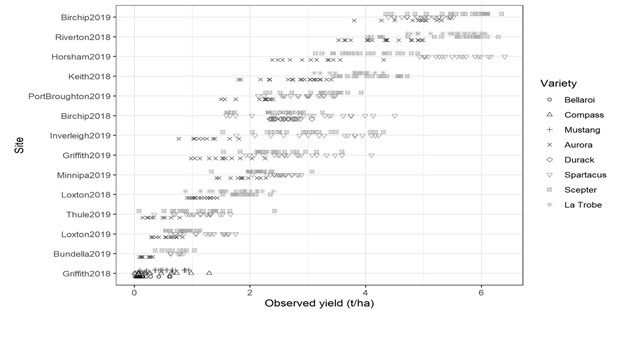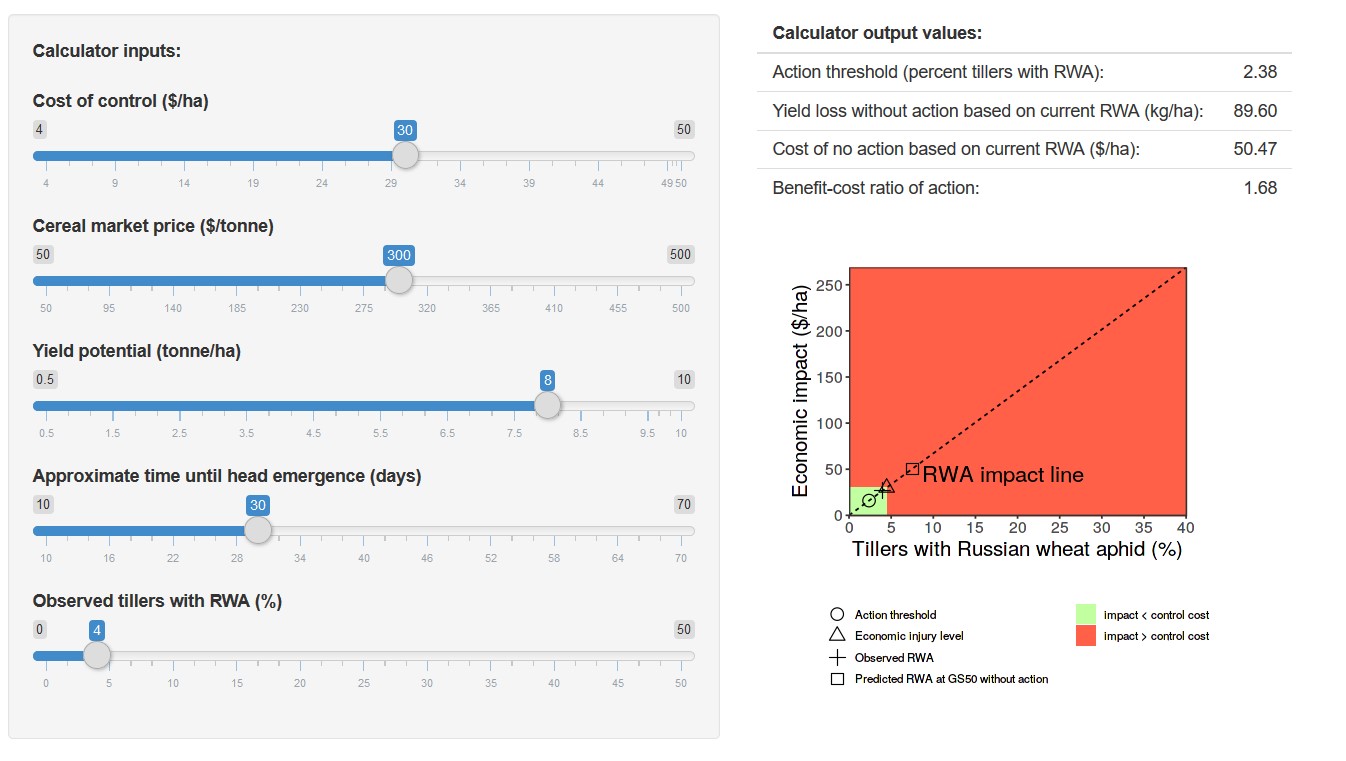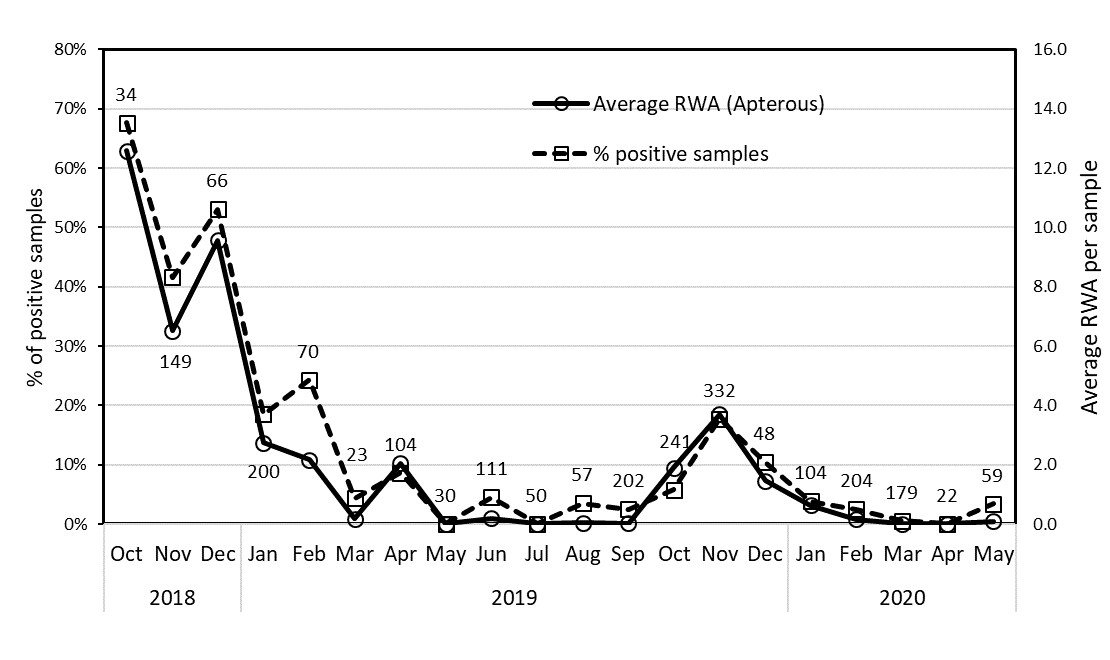Russian wheat aphid thresholds - insect density, yield impact and control decision-making
Author: Maarten van Helden (SARDI, University of Adelaide), Thomal Heddle (SARDI), Elia Pirtle, Jess Lye and James Maino (cesar Australia) | Date: 09 Feb 2021
Take home message
- Natural Russian wheat aphid (RWA) risk was nonsignificant in all 28 trials in 2018 and 2019.
- RWA yield impact is 0.28% yield loss per percent of tillers with RWA (%TwRWA).
- After GS30 the %TwRWA doubles approximately every 35 days.
- The RWA action threshold calculator is now available on-line and allows for an integrated pest management (IPM) approach to controlling RWA.
Background
This project studied the risk of infestation by the Russian wheat aphid (RWA, Diuraphis noxia (Kurdjimov 1913)) and its effect on yield in order to develop best management practices for RWA in an Australian context of winter cropping of short cycle cereals. Risk of yield loss depends on aphid invasion, subsequent pest development and sensitivity of the crop to the pest.
Previously, there were no data available for quantitative and qualitative yield effects of RWA and for the development of intervention thresholds in Australian cereal growing conditions. Overseas data, from North America and South Africa, where RWA has been present for many decades (Archer and Bynum 1992; Du Toit and Walters 1984; Du Toit 1986; Bennett 1990a,b; Kieckhefer and Gellner 1992; Girma et al. 1990, 1993; Mirik et al. 2009; Legg and Archer 1998, Chander et al. 2009), report a wide range of potential damage levels (yield loss and qualitative losses) and derived economic injury levels. Yield losses of around 0.5% per percentage of RWA infested tillers during stem elongation and grain filling are most frequently reported (Archer and Bynum 1992).
These knowledge gaps were addressed through:
- Twenty-eight natural RWA infestation field trials in 2018 (15) and 2019 (13) in South Australia (SA), Victoria (Vic), New South Wales (NSW) and Tasmania (Tas) (Table 1).
- Fifteen RWA inoculated field trials in 2018 (5) and 2019 (10) where 50 RWA/m2 (500,000 RWA/ha) were applied at GS12-14 (2-4 leaf stage, Table 1).
- Green bridge sampling of grasses during the non-cropping period in both years in all states and extensive continuous sampling of grasses in SA over 26 months (March 2018-May 2020).
Table 1. Location of trial sites in 2018 and 2019.
Site Name | State | Lat | Long | Inoculation | Irrigation |
|---|---|---|---|---|---|
2018 | |||||
Birchip | Vic | -35.9666 | 142.8242 | Y | N |
Cummins | SA | -34.3050 | 135.7189 | N | N |
Griffith | NSW | -34.1902 | 146.0920 | Y | N |
Hillston | NSW | -33.5482 | 145.4408 | N | Y |
Inverleigh | Vic | -38.1805 | 144.0390 | N | N |
Keith | SA | -36.1299 | 140.3233 | Y | N |
Lockhart | NSW | -35.0837 | 147.3280 | N | N |
Longerenong | Vic | -36.7432 | 142.1135 | N | N |
Loxton | SA | -34.4871 | 140.5891 | Y | N |
Minnipa | SA | -32.8398 | 135.1642 | N | N |
Nile DRY | Tas | -41.6759 | 147.3140 | N | N |
Nile IRR | Tas | -41.6759 | 147.3140 | N | Y |
Piangil | SA | -35.0519 | 143.2758 | N | N |
Riverton | SA | -34.2193 | 138.7350 | Y | N |
Yarrawonga | NSW | -36.0484 | 145.9833 | N | N |
2019 | |||||
Birchip | Vic | -35.9666 | 142.8242 | Y | N |
Bundella | NSW | -31.5851 | 149.9064 | N | N |
Cressy | Tas | -41.7854 | 147.1134 | Y | N |
Eugowra | NSW | -33.4944 | 148.3192 | N | N |
Griffith | NSW | -34.1902 | 146.0920 | Y | N |
Horsham | Vic | -36.7432 | 142.1135 | Y | N |
Inverleigh | Vic | -38.0497 | 144.0104 | Y | N |
Loxton | SA | -34.4871 | 140.5891 | Y | N |
Minnipa | SA | -32.8398 | 135.1642 | Y | N |
Mildura | Vic | -34.2627 | 141.8535 | Y | N |
Pt Broughton | SA | -33.5757 | 137.9987 | Y | N |
Thule | NSW | -35.6491 | 144.3914 | Y | N |
Yarrawonga | NSW | -36.0484 | 145.9833 | N | N |
Results
Risk of RWA invasion of crops
Overall RWA risk was very low during these two (very dry) years with no significant RWA infestation occurring in any of the non-inoculated field trials. Therefore, the largely adopted use of prophylactic seed treatments against RWA was not justified.
Yield loss in inoculated trials
Regional and varietal differences were large (Figure 1). In some, but not all of the inoculated field trials RWA populations reached population levels (maximum observed between GS40 and 50) resulting in yield loss. Of the various aphid pressure metrics, the best predictor of yield loss was the maximum percentage of tillers with RWA present (%TwRWA) with a 0.28% yield loss observed for every %TwRWA. This simple relationship applied to wheat, barley and durum wheat cereal types, years and regions (through the adjustment of potential yield), but oat did not allow RWA development. This yield impact is substantially lower than described for the USA (0.46-0.48%, Archer and Bynum 1992).

Figure 1. Yield across all trial sites and years with different cereal type/variety denoted by different markers. Barley varieties used were Compass, Spartacus CL and La Trobe. Durum wheat varieties used were EGA Bellaroi and DBA Aurora. Wheat varieties used were Scepter and Mustang. Oat variety used was Durack.
From this equation, the economic threshold (the break-even point of yield loss and control measures) can be calculated depending on the following parameters: cost of control (pesticide, applications costs), expected yield (region and year dependant and the farm-gate price of the crop (Figure 2).

Figure 2. An example of output from the RWA Action Threshold calculator.
RWA population development
After inoculation, the highest RWA populations that developed were in the drier regions, through a combination of increased RWA establishment during inoculation and an increased population increase. Less tillering in dry areas also contributed to higher %TwRWA. The maximum population of RWA and the maximum %TwRWA was reached between GS40 and 50 (Figure 3) followed by a decrease. Between the end of tillering (GS30) and GS50 an increase in the %TwRWA of 0.021%/%/day was observed. This would result in a doubling of the %TwRWA every 35 days.

Figure 3. Percentage of tillers with RWA (%TwRWA) against growth stage for the inoculated untreated control plots (AI-UTC) in all inoculated trial sites in 2019.
Action threshold calculator
Based on these observations and equations, a decision rule (action threshold, Figure 3) was proposed for RWA management using an observation of the percentage of tillers with symptoms and the %TwRWA at GS30. This observation and the expected increase in %TwRWA (based on the expected time to ear emergence, GS50) inform the need for management action, which can (if needed) be combined with existing treatments at GS 32-35, reducing application costs. Growers and advisers are directed to the GRDC calculator (Useful resources) to calculate thresholds for their growing conditions.
Green bridge risk
The environmental conditions over summer that form a ‘green bridge’ of suitable (grass) habitat between winter crops were expected to determine the risk of early colonisation events.
RWA detections were particularly common in field surveys during the spring to autumn periods (when no crops were present in the field), with high populations during spring in the warm dry grain growing regions of northern Vic, southern NSW and SA. During the summer, green vegetation for most grass species disappeared and RWA populations declined (Figure 4). Apart from volunteer cereals (wheat and barley), the majority of RWA detections were on five grass genera (barley grass, Bromus sp, phalaris, ryegrass and wild oat.

Figure 4. Dynamics of the percentage of positive samples (dotted line, left axis) and average RWA per sample (solid line, right axis) over time in South Australia. Numbers above markers show number of samples taken per month, n=2285.
Barley grass (Hordeum leporinum) and (to a lesser extent) brome grasses (Bromus sp.) are the host plants that showed the highest combination of abundance, positive RWA detection frequency and aphid numbers. These introduced species are not summer active in low rainfall areas, where the native bottlebrush (Enneapogon nigricans) is the most important summer refuge in low rainfall areas, because of its widespread distribution (207 samples collected from 135 sites) and summer growth pattern. Grazing and water availability (irrigation) can make some host grass populations, including prairie grass, couch grass, ryegrass and volunteer cereals, persist in summer. The presence of irrigated crops increased the likelihood of RWA detections 1.6-fold over the green bridge.
Early rainfall in late summer/autumn, two to three months before sowing, could cause RWA population to build up on grasses and cereal regrowth, potentially exacerbating early crop invasions. A 250mm high rainfall event in the Birchip area (Vic) in December 2018 did cause significant development of a green bridge but did not seem to result in an increased RWA risk. Reports in 2020 from the Port Augusta area (SA), where a significant summer rain occurred on 1 February suggested an increase in RWA pressure. This shows that observations, especially in early break years and a better understanding of aphid population dynamics and migration on the green bridge before and after sowing, are needed to obtain more precision on the impact of the green bridge and the risk and times of invasion of crops.
A ‘wetter’ year with a higher green bridge, or if immigration of aphids occurs at a higher level for some other reason, will not automatically result in a higher impact from RWA. Wetter and colder conditions and rainfall will be less favourable for RWA development in the crop (as can be seen from the Tasmanian trials) compared to the two experimental years (slowing down population development) and will also improve crop development which will better enable the crop to resist RWA.
Crop sensitivity
The project has shown similar yield impact and aphid population development for all crops tested except for oat, which is not an RWA host. However, crop and varietal differences in RWA establishment are likely to exist and have been reported. Also, the crop condition (growth stage, level of tillering, drought stress, nutritional stage) will play a role in RWA development and could result in a different risk for reaching population levels above thresholds.
Conclusion
RWA ecology and yield impact in Australia are now somewhat better understood. This allows growers and agronomists to manage RWA more sustainably and economically. Management based on observations and regionally adapted decision rules, rather than prophylactic seed treatments, will increase profitability, minimise chemical inputs and reduce off-target risks and resistance development.
The two years during which this study was conducted were very dry with hot summers and growing seasons. These conditions were unfavourable for RWA survival over summer, but favourable for the development of RWA in the inoculated trials (Baugh and Phillips 1991, De Farias et al. 1995). Some anecdotal observations in 2020, and in the few years that RWA has been known to be present in Australia (since 2016, Ward et al 2020, Yazdani et al 2018), do suggest that the population levels will be very different (but not necessarily more damaging) with different rainfall patterns. More experience and research are needed to better understand RWA ecology, and to improve the RWA management guidelines.
The geographical distribution of RWA is expected to increase further into northern NSW and Queensland (Avila et al. 2019), and RWA was detected in Western Australia in 2020. Different growing conditions (temperature, drought) and presence of other cereal crops, including summer cereals (rice, corn, sorghum, millet), and other grass hosts could alter the risk of RWA in those regions.
Acknowledgements
The research undertaken as part of this project is made possible by the significant contributions of growers through both trial cooperation and the support of the GRDC, the author would like to thank them for their continued support. Trials were run through multiple contractors requiring long hours of careful observations. Special thanks to Courtney Proctor, Bonnie Wake and Millie Moore for data management and long trips required for aphid inoculation and scoring trials, and Farah Al-Jawahiri for aphid rearings.
Useful resources
GRDC publication. Russian wheat aphid
References
Archer TL and Bynum EO 1992. Economic Injury Level for the Russian Wheat Aphid (Homoptera: Aphididae) on Dryland Winter Wheat. J Econ Entomol 85:987–992.
Avila GA, Davidson M, van Helden M and Fagan L 2019. The potential distribution of the Russian wheat aphid (Diuraphis noxia): an updated distribution model including irrigation improves model fit for predicting potential spread. Bulletin of Entomological Research 109, 90–101.
Baugh BA and Phillips SA 1991. Influence of population-density and plant water potential on Russian wheat aphid (Homoptera: Aphididae) alate production. Environmental Entomology 20, 1344-1348.
Bennett LE 1990a. Preliminary economic threshold level for Russian wheat aphid (RWA) Diuraphis noxia (Mordvilko), on dryland winter wheat in southeastern Wyoming. Final Report to the Wyoming Wheat Growers Association, 20 August 1990, Laramie, WY
Bennett LE 1990b. Economic damage, economic injury levels and economic threshold levels for Russian wheat aphid (RWA), Diuraphis noxia (Mordvilko), on winter barley in Wyoming. M.S. thesis, University of Wyoming, Laramie.
Chander S, Ahuja LR, Peairs FB, Aggarwal PK and Kalra N 2006. Modelling the effect of Russian wheat aphid Diuraphis noxia (Mordvilko) and weeds in winter wheat as guide to management, Agricultural Systems, vol. 88, pp. 494–513, 2006.
De Farias AMI, Hopper KR and Leclant F 1995. Damage symptoms and abundance of Diuraphis noxia (Homoptera: Aphididae) for four wheat cultivars at three irrigation levels. J. Econ. Entomol. 88: 169-174.
Du Toit F and Walters MC 1984. Damage assessment and economic threshold values for the chemical control of thr Russian wheat aphid, Diuraphis noxia (Mordvilko) on winter wheat. Tech Commun Dep Agric Repub South Africa 58–62
Du Toit F 1986. Economic thresholds for Diuraphis noxia (Hemiptera: Aphididae) on winter wheat in the eastern Orange Free State. Phytophylactica. 18, 107-109.
Girma M, Wilde G and Reese JC 1990. Influence of temperature and plant growth stage on development, reproduction, life span, and intrinsic rate of increase of the Russian wheat aphid (Homoptera: Aphididae). Environmental Entomology 19: 1438.
Girma M, Wilde GE and Harvey TL 1993. Russian wheat aphid (homoptera, aphididae) affects yield and quality of wheat. Journal of Economic Entomology. 86, 594-601.
Kieckhefer RW and Gellner JL 1992. Yield losses in winter wheat caused by low density cereal aphid populations. Agron. J. 84, 180–183.
Legg DE and Archer TL 1998. Sampling Methods, Economic Injury Levels, and Economic Thresholds for the Russian Wheat Aphid. In: Response Model for an Introduced Pest—The Russian Wheat Aphid. pp 313–336
Mirik M, Ansley J, Michels J and Elliott N 2009. Grain and vegetative biomass reduction by the Russian wheat aphid in winter wheat. Southwestern Entomologist 34, 131–139.
Ward S, van Helden M, Heddle T, Ridland PM, Pirtle E and Umina PA 2020. Biology, ecology and management of Diuraphis noxia (Hemiptera: Aphididae) in Australia. Austral Entomol. 59(2): 238-252.
Yazdani M, Baker G, DeGraaf H, Henry K, Hill K, Kimber B, Malapatil M, Perry K, Valenzuela I and Nash, MA 2018. First detection of Russian wheat aphid Diuraphis noxia Kurdjumov (Hemiptera: Aphididae) in Australia: a major threat to cereal production. Austral Entomol. 2018; 57: 410–417.
Contact details
Maarten van Helden
South Australian Research & Development Institute
GPO Box 397 Adelaide SA 5001
61 884290642
maarten.vanhelden@sa.gov.au
GRDC Project Code: UOA1805-018RTX,
Was this page helpful?
YOUR FEEDBACK
